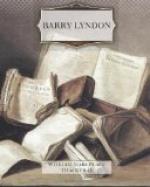|
This section contains 4,601 words (approx. 16 pages at 300 words per page) |

|
SOURCE: “The Perception of ‘History’ in Kubrick's Barry Lyndon,” in Literature/Film Quarterly, Vol. IX, No. 4, 1981, pp. 251-60.
In the following essay, Stephenson deems Barry Lyndon “an experiment in cinematic form” because of the realistic way Kubrick perceives and portrays history.
Stanley Kubrick's film Barry Lyndon, spectacular as it is, flies in the face of an audience's usual expectations about “costume drama” as a cinematic form of historical fiction. One cannot even say that the film is translating into cinematic form the style of its source, The Luck of Barry Lyndon by W. M. Thackeray. Thackeray's novel is much closer to the conventions of historical fiction, presenting a swaggering hero who undergoes a rapid series of adventures in high states of emotion. The film has a different style, which presents formidable obstacles to enjoyment by the viewer: a lethargic pace, a use of camera which forbids intimacy with...
|
This section contains 4,601 words (approx. 16 pages at 300 words per page) |

|


